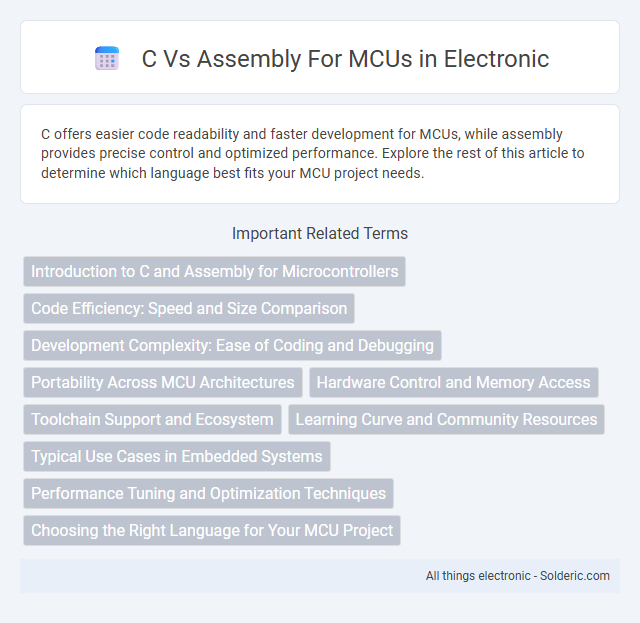C offers easier code readability and faster development for MCUs, while assembly provides precise control and optimized performance. Explore the rest of this article to determine which language best fits your MCU project needs.
Comparison Table
| Feature | C Language | Assembly Language |
|---|---|---|
| Abstraction Level | High-level, easier to read and write | Low-level, hardware-specific instructions |
| Code Efficiency | Moderate, depends on compiler optimizations | High, allows fine-tuned control for max efficiency |
| Development Speed | Faster, due to simplicity and better debugging tools | Slower, requires detailed hardware knowledge |
| Portability | High, easier to port across different MCUs | Low, tightly coupled with specific MCU architecture |
| Memory Usage | Higher, due to runtime overhead | Lower, precise memory control |
| Use Cases | General application development, complex algorithms | Time-critical tasks, bootloaders, hardware drivers |
| Learning Curve | Moderate, requires knowledge of syntax and logic | Steep, requires detailed knowledge of MCU internals |
Introduction to C and Assembly for Microcontrollers
C language offers a high-level, structured approach to microcontroller programming, enabling easier code maintenance and portability across different MCU architectures. Assembly language provides low-level, hardware-specific instructions that allow precise control over processor resources, essential for time-critical and resource-constrained applications. Developers often balance C's abstraction and Assembly's efficiency to optimize performance in embedded systems.
Code Efficiency: Speed and Size Comparison
Assembly language offers unparalleled control over code optimization, enabling maximal speed and minimal size by directly managing CPU instructions, which is crucial for resource-constrained MCUs. C provides high-level abstractions that improve development speed and maintainability, but its compiled code can be less efficient in terms of execution time and memory footprint compared to hand-tuned assembly. When prioritizing code efficiency for MCUs, especially in critical performance or size-sensitive applications, your choice between C and Assembly should weigh the trade-off between optimization potential and programming complexity.
Development Complexity: Ease of Coding and Debugging
C offers higher-level abstractions that simplify coding and debugging for MCUs, reducing development complexity compared to Assembly's low-level, hardware-specific instructions. While Assembly provides granular control essential for performance-critical sections, it demands more expertise and time to write and troubleshoot. Choosing C can accelerate your development process with more manageable code and better debugging tools.
Portability Across MCU Architectures
C offers superior portability across MCU architectures due to its high-level abstraction, allowing code to run on various microcontrollers with minimal changes. Assembly language must be rewritten for each MCU's specific instruction set, limiting reuse and increasing development time. Optimizing Your code in C balances portability and performance, while Assembly demands intimate knowledge of hardware for architecture-specific optimizations.
Hardware Control and Memory Access
Assembly language offers precise hardware control and direct memory access on microcontrollers (MCUs), enabling manipulation of specific registers and I/O pins with minimal latency. C provides high-level abstractions that simplify code development and portability but may introduce overhead due to function calls and compiler-generated instructions. Optimized C compilers can produce efficient code close to assembly performance while maintaining readability and maintainability.
Toolchain Support and Ecosystem
C language offers extensive toolchain support and a robust ecosystem for microcontroller units (MCUs), with numerous integrated development environments (IDEs), compilers, and debugging tools available from vendors like ARM, Microchip, and STMicroelectronics. Assembly language provides lower-level control but has limited toolchain options, often requiring specialized assemblers and less user-friendly debugging interfaces. The widespread adoption of C ensures easier integration with libraries, real-time operating systems (RTOS), and middleware, enhancing development efficiency for embedded systems.
Learning Curve and Community Resources
C offers a gentler learning curve compared to Assembly, making it ideal for developers new to microcontroller programming by providing high-level abstractions that simplify hardware interactions. Assembly language demands a deep understanding of MCU architecture and instruction sets, resulting in a steeper learning curve but granting you precise control over performance and memory usage. Extensive community resources, including libraries, forums, and tutorials, are more abundant for C, accelerating development and troubleshooting for embedded systems projects.
Typical Use Cases in Embedded Systems
C is widely used for developing embedded systems due to its balance of readability, portability, and efficiency, making it ideal for applications that require rapid development and maintainable code like IoT devices, automotive controllers, and consumer electronics. Assembly language is preferred for time-critical or hardware-specific tasks where direct control over processor instructions is needed, such as bootloaders, real-time operating systems, and device drivers. Your choice depends on whether you prioritize ease of development and cross-platform compatibility (C) or maximum performance and minimal resource usage (Assembly).
Performance Tuning and Optimization Techniques
Assembly language provides granular control over hardware resources, enabling developers to implement highly efficient performance tuning tailored to specific microcontroller architectures. C language, while offering platform abstraction and easier code maintenance, relies on compiler optimizations such as loop unrolling, inline assembly, and intrinsic functions to approach hand-optimized assembly speed. Effective optimization in MCUs often combines C for general logic with selective assembly for critical performance paths to balance code readability with execution speed.
Choosing the Right Language for Your MCU Project
Selecting the right language for your MCU project hinges on balancing development speed with control over hardware. C offers high portability and easier debugging, making it ideal for complex applications requiring faster development. Assembly language provides unmatched precision and efficiency, crucial for performance-critical tasks where every cycle counts.
C vs Assembly for MCUs Infographic

 solderic.com
solderic.com